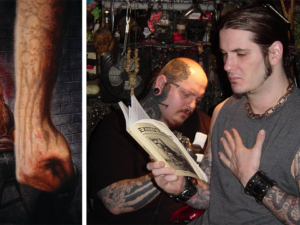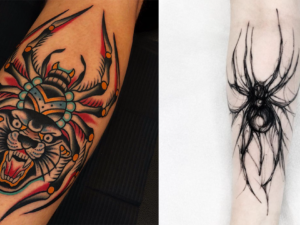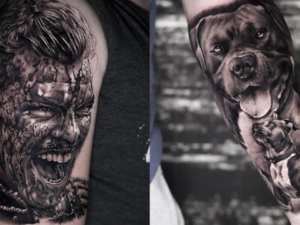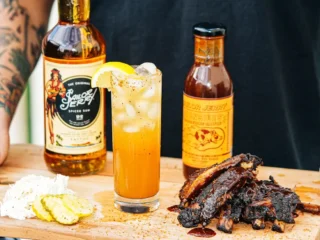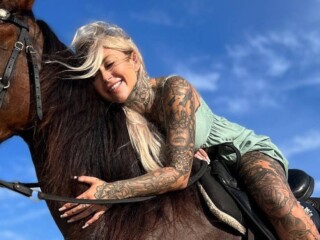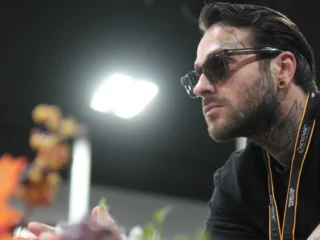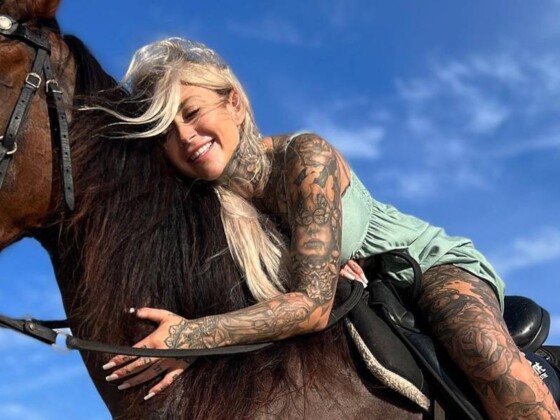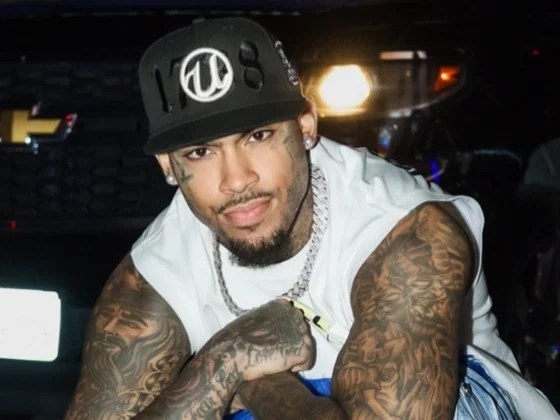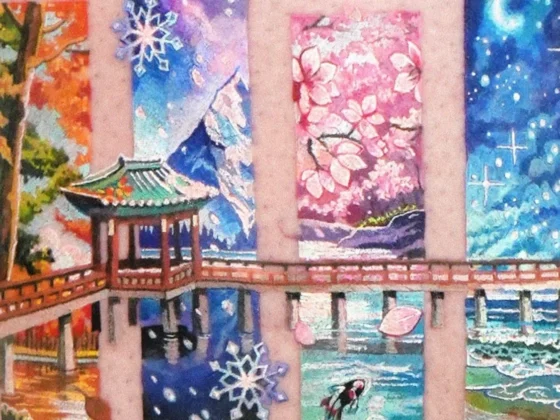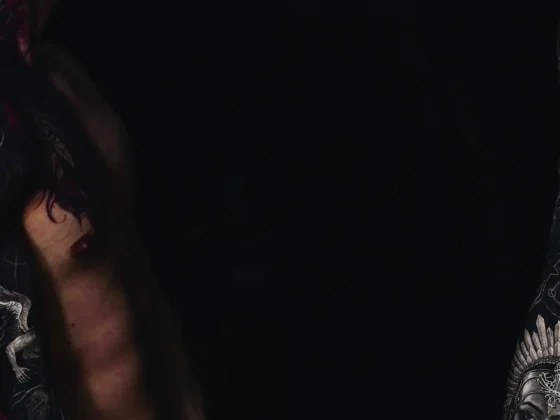Inked Mag
January 8th, 2019
Josh Lord Exclusive: Celebrity Tattooer, Hollywood’s Hero, and Covert Artist During NYC’s Illegal Tattoo Scene
East Side Ink owner, Josh Lord, tells INKED about tattooing—and getting tattooed—by the Avengers, as well as his faux tattoos behind sets like Sisters, Blindspot, The Last Airbender, and HBO’s True Detective.
East Side Ink owner, Joshua Lord, is the tattoo artist behind many celebrities’ tattoos, including, Cate Blanchett; Aerosmith’s Joe Perry; Dee Dee Ramone; and most recently, the cast of Avengers: Infinity War.
Before these blessings, as Lord calls them, he had to show his teeth through New York City’s illegal tattooing scene.

Josh Lord reflects on his 20-year tattooing career, with INKED.
Before learning to tattoo from a shop in St. Marks Place—which was one of the many that frequently paid the NYPD to turn the other way during New York City’s illegal tattooing scene in the late ‘90s—Josh Lord had frequently moved around from his birthplace in New Mexico, since childhood.
“The best way I usually describe my early days to people is that I went to more schools than I did grades,” Lord said. “My earliest childhood memories are of the house that my parents built themselves. We had no electricity or running water, so that sets the mood.”

After settling into Rochester for high school, Lord knew he wanted to leave his wait-staff job for something that he “could build on or show some kind of progress.”
“It was just a lot of short term conversations with a lot of people,” Lord said. “Little did I know that it was going to be tattooing, but that led me on a search of all the things that I might want to do.”

The two options that he was choosing between, was either: an apprenticeship with Albert Paley, a Rochester ironworker that has beautiful work all over the city; or an offer to work at a tattoo shop in the deep ghetto of Rochester—despite not knowing how to tattoo.
Lord chose to work at the “ghetto tattoo shop” in Rochester.
“It was a very low standard shop. The owner had gotten out of jail and started tattooing instantly, without any real knowledge of what they were doing,” Lord said. “Instead of working with this phenomenal, amazingly talented ironworker, I chose the tattoo shop… mostly because I didn’t want to get up at six in the morning every day.”

Leaving the food industry for the tattoo industry made sense, because the two worlds are so intertwined. He also leaned that way, as “a big middle finger in the air.”
Lord soon realized that the tattooers in the shop “had no idea what they were doing.”
“This is just stuff that they learned in jail without actual machines,” he added.

A combination of Lord’s slight slant of the truth about his previous tattoo experience, and the shop having such low standards, Lord had started working there as a tattoo artist from “the very first day.”
“I can’t emphasize how low the standards were. People would come in every day and bargain for tattoos that cost $15, because that was too much money for them,” he said. “It was just the kind of horrible place that I hope nobody ever has to set foot in to get a tattoo… but they always will exist.”
Although the shop would never provide the professional progression Lord had sought out, it did help him realize how much he loved the art form.
This new love, had also made him realize he had a lot of work to put in.

“It was so much more difficult than I thought it would be,” Lord said. “It really seemed like a skill you could fake, which technically, I guess I did, but as any tattooer knows, sometimes it takes a year just to be able to do a straight line before you get down the subtleties.”
Lord’s next step would be to “tackle it for real,” by throwing himself into New York City. With very limited equipment and six months of “actual tattooing experience,” he figured if he didn’t give himself any other choice, there would be no backing out.

“I had a really terrible, simplistic portfolio; $600 bucks in my pocket; and no job and nowhere to stay,” Lord said. “And that was my introduction to New York.”
Little did he know, he would soon be affiliated with envelope-payoffs to the mob.
It was still illegal to tattoo when Lord arrived to the city, and although New York was starting to loosen the strict rules at that point, Lord “got a little taste of that world,” working at a shop owned by Jonathan Shaw in St. Marks, until four in the morning.
“While tattoos were still technically illegal, they were kind of tolerated. The shop I worked at had a big banner out front that said ‘cappuccino… and tattoos,’” Lord said. “But we didn’t actually serve cappuccinos.”

While Lord wishes he didn’t miss the era of secret codes and door knocks, or the busses that would take you right outside of the city line to get your ink, tattoos becoming more “tolerated” allowed the professional progression he was searching for.
That said, he still witnessed the regular bribery envelopes.
“There was an envelope for the motorcycle gang that watched out for us—whose name I will not mention—and there was an envelope for the boys in blue who left us alone, and also got free tattoos,” Lord said. “Then there was a bigger envelope for the mob, and that was our regular way of doing business.”
Lord notes that, while he had nothing to do with the “brain work in the bribery system,” his main role was being a “tattoo slave,” working 12-hour days, seven days a week.
He would sleep in the shop and open it up again at noon, “repeating the whole day for years.”

However, Lord equally needed and wanted the practice.
“I needed to get my chops down and catch up to all the great artists that were around the city,” he said. “It would force me to do the kind of work that you can really only do in your early twenties.
He added, “No way I could keep up with that pace now.”
Lord took what he learned from the gritty tattoo scene that New York offered, to continue mastering his craft.
…Although, “for many years,” his mother had told people that he was a dentist.
“I pretty much learned tattooing just out of stubbornness more than any kind of guidance at that point,” Lord said. “Until I went on to my next shop, East Side Ink, where I had wonderful artists around me to learn from.”

Before owning East Side Ink, which Lord applauds as being “arguably the first shop in the city,” when it first opened, he credits learning from the masters at the shop.
Artists including, but not limited to: Andrea Elston, the first opener of East Side Ink, and the artists who worked there, Patrick Conlon and Nalla Smith.
“Those are the three people that I absolutely idolized and wanted to be more like, and put all my efforts into being, at least, good enough to work with,” Lord said.
“These guys were already kind of famous long before I even started tattooing. So while it was a struggle, it was a beautiful and wonderful chapter of my New York memories.”

With the service industry still very much ingrained in Lord’s work ethic, his goal was to bring some of it to the tattoo scene.
Through East Side Ink, Lord wanted to deliver some key components he appreciated from his time bartending and waiting tables.
The first, being, “actual customer service.”
“Being nice to people doesn’t sound like a big deal now, because there is a lot of competition now and people are nice, but it wasn’t really the case in my memory,” Lord said.

Lord remembers many of the shops being standoffish, radiating the energy that “you were lucky to be there, not that they were lucky to have you there.”
The other integration Lord wanted to incorporate was the idea of the open kitchen.
“So many restaurants that I worked at had an open kitchen so you could see what was going on,” Lord said. “And every tattoo shop back then had a red front-room full of art, and then a grumpy person in a tiny window, who would take you into the back in separate rooms, and put you with somebody scary.”

“It was a very different mood. And now I’d like to say that almost all the shops kind of follow that open kitchen system,” Lord continued. “Pretty sure that we were the first, so I’m proud of that. I definitely am grateful for my time in the service industry.”
Lord’s commendation to his time working in the service world had come full circle, when he and some friends opened a restaurant, called VBar St. Marks, just down the street from the St. Marks shop he first worked at, eight years ago.

“I didn’t run the restaurant, I just did the aesthetics and the design. But it was where I had my first drink to celebrate my first job in the city,” Lord said.
VBar St. Marks had “made it for almost 10 years” before closing, but eventually turned into what is now Waiting on A Friend.

Through his professional journey, Lord had always used his OCD to his advantage, to master the formula that all tattoos are made up of: line work, shading, and solid fill in.
“For years all I worked on was consistently getting any quality of line to look good; a subtle shading, from one gradient to the next; and the fill,” Lord said. “Being OCD is a great characteristic for tattooers. Not for every job, but definitely for that one.”
Soon after, Hollywood celebrities were wearing Lord’s detail-oriented work.
Most recently, Lord tattooed the cast of the Avengers.

Lord had previously inked “longest-running celebrity customer and dear friend” Scarlett Johansson, who had brought up the idea to include Robert Downey Jr., Chris Hemsworth, Mark Ruffalo, Jeremy Renner, and Chris Evans, in on the fun.
The hardest part of creating the Avengers’ tattoo, was getting “the six biggest actors on the planet to agree on one design.”
https://www.instagram.com/p/BihyLa2lGb4
Lord said, “Although the design is relatively simple, it had to be masculine enough for some and feminine enough for others. It incorporated each of their symbols and all of their initials, but still be a simple design that all of them would actually get.”

This simple design took months, and pages and pages of options.
Of course, the final product was universally loved by all participants. Lord shares that although the tattoo itself “was an incredible honor,” the tattoo artist was also honored by being “in on the secret.”

“Robert Downey Jr specifically swore us all to secrecy, so no one would talk about the tattoo,” Lord said. “And then, the next day at the premier, it was like the first thing he said. He pointed at us in the audience and gave us a little wink, and blew us a kiss, it was really cute.”
While Mark Ruffalo had “personal reasons for backing out,” Downey Jr, Hemsworth, Evans, and Johansson returned the favor, by tattooing Lord’s “junk leg.”

“With respect to the one that my wife did on me, of course, that’s pretty much my favorite tattoo,” Lord said. “It was just a phenomenally hilarious experience all around. I was really lucky to witness it as a fan, and as an old school, comic book nerd.”
“Everyone’s personality really came out in the lines, and everyone took it seriously. I’d say the people who really did the best were Jeremy Renner and Chris Evans,” Lord said. “Those guys really showed off a little bit.”

Lord added, “Chris Hemsworth really hurt me. He dug in right to my bone I think. I think he was getting revenge for his ribs.” Laughing, Lord said, “He is very strong.”
Hollywood is also graced by Josh Lord’s work, for celebrities on-screen.
Lord is the designer behind the faux tattoos you see in Tina Fey and Amy Poehler’s Sisters, NBC’s series Blindspot, M. Night Shyamalan’s The Last Airbender, the first season of HBO’s True Detective, and assisted the incredibly badass chest-piece on Keanu Reeves in The Private Lives of Pippa Lee.

“When I’m lucky, I get the scripts, the storyline, and a lot of communication between everybody involved in the decision making process,” Lord said. “I want the tattoos to really look real and done in the style that they should be done for the era.”
While Lord enjoys being able to take his time, and let his OCD roam free, he does design faux tattoos “on the fly” for a production, like he did with NBC’s upcoming show, The Village.
“They needed full sleeves and neck pieces for various characters, all designed and tested within two days,” Lord said. “That’s something I’m happy to do because it’s fun to be a part of things, but I always love it when I have more time and an input.”

From doing this work and participating on so many sets, Josh’s new pet peeve is seeing faux tattoos on screen that “look really fake.”
He laughed, “It totally ruins shows for me because I just fixate on them.”
Lord’s first fake-tattoo transfer was for Keanu Reeves. Assisting Patrick Conlon, who designed Reeves’ huge, full chest-piece, required drawing the piece on Reeves’ chest by hand.
Lord explains that this is because lower-budget movies do not call for the “fancy, expensive stickers” that productions like The Last Airbender necessitates, where there are a lot of “[tattoo] scenes, actors, stunt doubles, and stand ins.”

“The drawing took about three hours for every time he was shirtless,” Lord said. “While this was my introduction to faux tattoos, the highpoint of my fake-tattoo career was getting called in by Cary Joji Fukunaga, the genius, brilliant director behind True Detective‘s fame.”
“That was a set where they gave me a good six months to work on that,” Lord said. “We went back and forth trying hundreds of different designs before settling on the specific designs for the main characters, the biker gangs, the nazi pedophiles, etcetera.”

Lord said he is “very, very proud of these tattoos,” because everything behind them, including the art in making the tattoos look faded as the characters age, had been crafted with care.
“The director’s view was so brilliant, and all the people involved had brilliant things to say. Everyone cared, you know?” Lord said. “No one was going to settle for anything but perfection on that.”

Lord has even had a hand in persuading actors to get a real ink, after they were so fond of their faux tattoo.
Blindspot’s Jaimie Alexander had eventually went under the tattoo needle after Lord’s help for, what he thinks is, “the most fake-tattooed show, I think ever.”
“I was lucky enough to work with her for quite a while, with various tattoo applications for her and other cast members on Blindspot,” he said. “We talked a lot about all the possible tattoos that she might’ve wanted. Finally, she got an awesome beetle on her hip.”

As Lord has contributed to helping the tattoo scene—from the old school, gritty New York City, to today’s Hollywood heroes—INKED asked Josh Lord how he would want to leave the tattoo industry. Not only better than when he found it, but even after helping push it to what it is today.
“We kind of stand on the shoulders of the giants before us,” he said. “When I started, there weren’t a lot of really highly, detailed-focused artists. It just was a different world of tough guys. Especially in New York.”
“To a lot of people, surviving at four in the morning on Saint Marks was more important than tattoos being perfect.”
This is why his focus was always, and will always be, with extreme attention to detail.
“If you work hard on the details that no one sees, then everything that they do notice will have to be good,” Lord said. “If I do have any legacy, I hope it would be for not only creating a tattoo a client is happy to look at, but one that gives them joy, with their memories associated with the tattoo experience.”
“I always tried to make sure that every person’s tattoo was taken absolutely seriously. And there’s no really small tattoos to me,” he continued. “They’re all just equally as important to the person getting it. That’s what I want people to leave with, a really positive experience.”
Lord said that even without his spotlight on attention to detail, and for extending the enjoyment and appreciation of tattooing as an art form, beyond the bikers; gangbangers; and “tough guys,” the “next generation of artists were already so much more different, and more impressive in their skills, than the ones that were around prior.”
He humbly added, “So I can’t say that I really influenced that too much, I was just lucky enough to be a part of that wave.”
“Everybody you’ve touched, it should make their life a little bit better,” he continued. “Not a little bit worse.”
Editor's Picks
Paul Booth Illustrates Cover for Pantera Graphic Novel
The revered tattoo artist created a cover for a graphic novel celebrating the 30th anniversary of “Vulgar Display of Power”
Scary Spider Tattoos
Spiders are terrifying, yet for some reason people sure do love to get tattoos of them


